by Calculated Risk on 3/15/2023 07:00:00 AM
Wednesday, March 15, 2023
MBA: Mortgage Purchase Applications Increased in Weekly Survey
From the MBA: Mortgage Applications Increase in Latest MBA Weekly Survey
Mortgage applications increased 6.5 percent from one week earlier, according to data from the Mortgage Bankers Association’s (MBA) Weekly Mortgage Applications Survey for the week ending March 10, 2023.
The Market Composite Index, a measure of mortgage loan application volume, increased 6.5 percent on a seasonally adjusted basis from one week earlier. On an unadjusted basis, the Index increased 7 percent compared with the previous week. The Refinance Index increased 5 percent from the previous week and was 74 percent lower than the same week one year ago. The seasonally adjusted Purchase Index increased 7 percent from one week earlier. The unadjusted Purchase Index increased 8 percent compared with the previous week and was 38 percent lower than the same week one year ago.
“Treasury yields declined late last week, as market concerns over bank closures and the potential for broader ripple effects triggered a flight to safety in Treasury bonds. This decline pushed mortgage rates for all loan types lower, with the 30-year fixed rate decreasing to 6.71 percent,” said Joel Kan, MBA’s Vice President and Deputy Chief Economist. “Home-purchase applications increased for the second straight week but remained almost 40 percent below last year’s pace. While lower rates should buoy housing demand, the financial market volatility may cause buyers to pause their decisions.”
Added Kan, “Refinance activity remained more than 70 percent behind last year’s level, as rates are still more than two percentage points higher than a year ago. The dip in rates did bring some borrowers back as evidenced by the 5 percent increase in refinance applications last week.”
..
The average contract interest rate for 30-year fixed-rate mortgages with conforming loan balances ($726,200 or less) decreased to 6.71 percent from 6.79 percent, with points decreasing to 0.79 from 0.80 (including the origination fee) for 80 percent loan-to-value ratio (LTV) loans.
emphasis added
 Click on graph for larger image.
Click on graph for larger image.The first graph shows the refinance index since 1990.
Tuesday, March 14, 2023
Wednesday: Retail Sales, PPI, NY Fed Mfg, Homebuilder Survey
by Calculated Risk on 3/14/2023 08:06:00 PM

Wednesday:
• At 7:00 AM ET, The Mortgage Bankers Association (MBA) will release the results for the mortgage purchase applications index.
• At 8:30 AM, Retail sales for February is scheduled to be released. The consensus is for a 0.3% decrease in retail sales.
• Also at 8:30 AM, The Producer Price Index for February from the BLS. The consensus is for a 0.3% increase in PPI, and a 0.4% increase in core PPI.
• Also at 8:30 AM, The New York Fed Empire State manufacturing survey for March. The consensus is for a reading of -7.7, down from -5.8.
• At 10:00 AM, The March NAHB homebuilder survey. The consensus is for a reading of 41, down from 42. Any number below 50 indicates that more builders view sales conditions as poor than good.
Q4 Update: Delinquencies, Foreclosures and REO
by Calculated Risk on 3/14/2023 04:47:00 PM
Today, in the Calculated Risk Real Estate Newsletter: Q4 Update: Delinquencies, Foreclosures and REO
A brief excerpt:
In 2021, I pointed out that with the end of the foreclosure moratoriums, combined with the expiration of a large number of forbearance plans, we would see an increase in REOs in late 2022 and into 2023. However, this would NOT lead to a surge in foreclosures and significantly impact house prices (as happened following the housing bubble) since lending has been solid and most homeowners have substantial equity in their homes.There is much more in the article. You can subscribe at https://calculatedrisk.substack.com/
Last week, CoreLogic reported on homeowner equity: US Annual Home Equity Gains Cool Again in Q4 2022, CoreLogic ReportsThe report shows that U.S. homeowners with mortgages (which account for roughly 63% of all properties) saw equity increase by 7.3% year over year, representing a collective gain of $1 trillion, for an average of $14,300 per borrower, since the fourth quarter of 2021.With substantial equity, and low mortgage rates (mostly at a fixed rates), few homeowners will have financial difficulties.
...
Here is some data on REOs through Q4 2022 …
...
This graph shows the nominal dollar value of Residential REO for FDIC insured institutions. Note: The FDIC reports the dollar value and not the total number of REOs.
The dollar value of 1-4 family residential Real Estate Owned (REOs, foreclosure houses) increased from $818 million in Q3 2022 to $829 million in Q4 2022. This is increasing, but still very low.
...
The bottom line is there will be an increase in foreclosures in 2023 (from record low levels), but it will not be a huge wave of foreclosures as happened following the housing bubble. The distressed sales during the housing bust led to cascading price declines, and that will not happen this time.
2nd Look at Local Housing Markets in February
by Calculated Risk on 3/14/2023 11:42:00 AM
Today, in the Calculated Risk Real Estate Newsletter:
2nd Look at Local Housing Markets in February
A brief excerpt:
This is the second look at local markets in February. I’m tracking about 40 local housing markets in the US. Some of the 40 markets are states, and some are metropolitan areas. I’ll update these tables throughout the month as additional data is released.There is much more in the article. You can subscribe at https://calculatedrisk.substack.com/
...
In February, sales in these markets were down 23.1%. In January, these same markets were down 33.8% YoY Not Seasonally Adjusted (NSA).
This is a significantly smaller YoY decline NSA than in January for these early reporting markets.
The early data suggests NAR reported sales will rebound in February. This will still be a significant YoY decline, and the 18th consecutive month with a YoY decline.
...
Many more local markets to come!
Cleveland Fed: Median CPI increased 0.6% and Trimmed-mean CPI increased 0.5% in February
by Calculated Risk on 3/14/2023 11:23:00 AM
The Cleveland Fed released the median CPI and the trimmed-mean CPI:
According to the Federal Reserve Bank of Cleveland, the median Consumer Price Index rose 0.6% in February. The 16% trimmed-mean Consumer Price Index increased 0.5% in February. "The median CPI and 16% trimmed-mean CPI are measures of core inflation calculated by the Federal Reserve Bank of Cleveland based on data released in the Bureau of Labor Statistics’ (BLS) monthly CPI report".
 Click on graph for larger image.
Click on graph for larger image.This graph shows the year-over-year change for these four key measures of inflation.
Note: The Cleveland Fed released the median CPI details. "Fuel oil and other fuels" decreased at a 55% annualized rate in February, and "Used Cars" decreased at a 29% annualized rate.
YoY Measures of Inflation: Services, Goods and Shelter
by Calculated Risk on 3/14/2023 09:07:00 AM
Here a few measures of inflation:
The first graph is the one Fed Chair Powell has been mentioning.
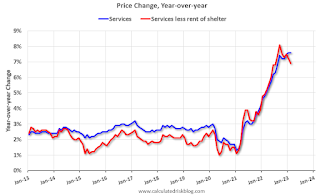
This graph shows the YoY price change for Services and Services less rent of shelter through February 2023.
Services less rent of shelter was up 6.9% YoY in February, down from 7.2% YoY in January.
 The second graph shows that goods prices started to increase year-over-year (YoY) in 2020 and accelerated in 2021 due to both strong demand and supply chain disruptions.
The second graph shows that goods prices started to increase year-over-year (YoY) in 2020 and accelerated in 2021 due to both strong demand and supply chain disruptions.Commodities less food and energy commodities were up 1.0% YoY in February, down from 1.3% YoY in January.
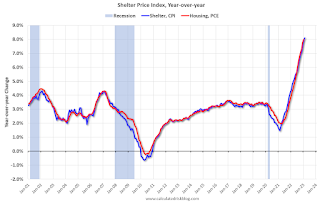 Here is a graph of the year-over-year change in shelter from the CPI report (through February) and housing from the PCE report (through January 2023)
Here is a graph of the year-over-year change in shelter from the CPI report (through February) and housing from the PCE report (through January 2023)Shelter was up 8.1% year-over-year in February, up from 7.9% in January. Housing (PCE) was up 8.0% YoY in January.
The BLS noted this morning: "The index for shelter was the largest contributor to the monthly all items increase, accounting for over 70 percent of the increase [in CPI]".
BLS: CPI increased 0.4% in February; Core CPI increased 0.5%
by Calculated Risk on 3/14/2023 08:34:00 AM
The Consumer Price Index for All Urban Consumers (CPI-U) rose 0.4 percent in February on a seasonally adjusted basis, after increasing 0.5 percent in January, the U.S. Bureau of Labor Statistics reported today. Over the last 12 months, the all items index increased 6.0 percent before seasonal adjustment.Both CPI and core CPI were close to expectations. I'll post a graph later today after the Cleveland Fed releases the median and trimmed-mean CPI.
The index for shelter was the largest contributor to the monthly all items increase, accounting for over 70 percent of the increase, with the indexes for food, recreation, and household furnishings and operations also contributing. The food index increased 0.4 percent over the month with the food at home index rising 0.3 percent. The energy index decreased 0.6 percent over the month as the natural gas and fuel oil indexes both declined.
The index for all items less food and energy rose 0.5 percent in February, after rising 0.4 percent in January. Categories which increased in February include shelter, recreation, household furnishings and operations, and airline fares. The index for used cars and trucks and the index for medical care were among those that decreased over the month.
The all items index increased 6.0 percent for the 12 months ending February; this was the smallest 12-month increase since the period ending September 2021. The all items less food and energy index rose 5.5 percent over the last 12 months, its smallest 12-month increase since December 2021. The energy index increased 5.2 percent for the 12 months ending February, and the food index increased 9.5 percent over the last year.
emphasis added
Monday, March 13, 2023
Tuesday: CPI
by Calculated Risk on 3/13/2023 08:43:00 PM
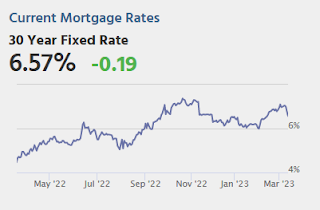
If you're just getting caught up or otherwise haven't heard, the biggest news in financial markets since last Friday has been the precipitous failure of Silicon Valley Bank. While not necessarily a household name, SVB was the 16th largest bank in terms of assets and the 2nd biggest bank failure in history behind Washington Mutual 15 years ago.Tuesday:
Combine that with the fact that the 3rd largest bank failure in history (Signature Bank) occurred 2 days later and it's no surprise that there's some panic in financial markets about systemic risk (aka, a domino effect resulting in additional turmoil).
...
If the market is calmer, then why are rates still so much lower? This has to do with the market shifting its expectations for Fed rate hikes in the rest of 2023. Specifically, the market now sees the Fed hitting a ceiling rate that's more than 1.5% lower than it was at the beginning of last week! [30 year fixed 6.57%]
emphasis added
• At 6:00 AM ET, NFIB Small Business Optimism Index for February.
• At 8:30 AM, The Consumer Price Index for February from the BLS. The consensus is for a 0.4% increase in CPI, and a 0.4% increase in core CPI. The consensus is for CPI to be up 6.0% Year-over-year (YoY), and core CPI to be up 5.5% YoY.
Bank Failure #2 in 2023: Silicon Valley Bank
by Calculated Risk on 3/13/2023 04:43:00 PM
Note: There were over 500 bank failures during and immediately following the GFC, and almost 300 in just 2009 and 2010. That was mostly due to default risk (poor performing MBS). I don't expect a large wave of failures now.
From the FDIC: FDIC Establishes Signature Bridge Bank, N.A., as Successor to Signature Bank, New York, NY
Signature Bank, New York, NY, was closed today by the New York State Department of Financial Services, which appointed the Federal Deposit Insurance Corporation (FDIC) as receiver. To protect depositors, the FDIC transferred all the deposits and substantially all of the assets of Signature Bank to Signature Bridge Bank, N.A., a full-service bank that will be operated by the FDIC as it markets the institution to potential bidders. ... Signature Bank had total assets of $110.4 billion and total deposits of $88.6 billion as of December 31, 2022. As receiver, the FDIC will operate Signature Bridge Bank, N.A. to maximize the value of the institution for a future sale and to maintain banking services in the communities formerly served by Signature Bank.
Pandemic Economics, Housing and Monetary Policy: Part II
by Calculated Risk on 3/13/2023 10:32:00 AM
Today, in the Calculated Risk Real Estate Newsletter: Pandemic Economics, Housing and Monetary Policy: Part 2
A brief excerpt:
Special Note: This was mostly written prior to the failure of Silicon Valley Bank. Now it appears the Fed might pause in March. Goldman Sachs economists wrote last night: “we no longer expect the FOMC to deliver a rate hike at its next meeting on March 22 (vs. our previous expectation of a 25bp hike)”, although BofA economists wrote this morning “After the latest developments around Silicon Valley Bank and the Fed, we retain our outlook for a 25bp hike in March.”There is much more in the article. You can subscribe at https://calculatedrisk.substack.com/
In Part 1 of Pandemic Economics, Housing and Monetary Policy I noted that pandemic economic outcomes were frequently largely unexpected. And that this has been especially true for housing.
Housing is the key transmission mechanism for monetary policy. And we need to be on the lookout for pandemic distortions to normal economic patterns - especially in housing - and hope that the Federal Open Market Committee (FOMC) will adjust monetary policy accordingly.
Many analysts are puzzled about why the economy hasn’t slowed quicker given the rapid increase in the Fed Funds rate over the last year. Some analysts are even concerned about “premature reacceleration”. Some analysts are even concerned about “premature reacceleration”. Goldman Sachs economists wrote last week:“In recent months we have argued that the drag on GDP growth from last year’s fiscal and monetary policy tightening is fading, not growing, and that this means that the key risk for the economy is a premature reacceleration, not an imminent recession.”When I read some of the recent comments from FOMC members, I’m reminded of a great scene from the movie China Syndrome where a stuck indicator almost led to catastrophic failure.
emphasis added
Housing March 13th Weekly Update: Inventory Decreased 1.5% Week-over-week
by Calculated Risk on 3/13/2023 08:47:00 AM
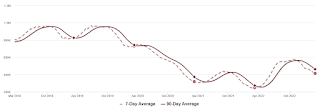 Click on graph for larger image.
Click on graph for larger image.This inventory graph is courtesy of Altos Research.

Mike Simonsen discusses this data regularly on Youtube.
Sunday, March 12, 2023
Sunday Night Futures
by Calculated Risk on 3/12/2023 06:12:00 PM
Weekend:
• Schedule for Week of March 12, 2023
Monday:
• At 10:00 AM ET, State Employment and Unemployment (Monthly) for January 2023
From CNBC: Pre-Market Data and Bloomberg futures S&P 500 futures are up 8 and DOW futures are up 40 (fair value).
Oil prices were up over the last week with WTI futures at $76.68 per barrel and Brent at $82.78 per barrel. A year ago, WTI was at $109, and Brent was at $118 - so WTI oil prices are DOWN 30% year-over-year.
Here is a graph from Gasbuddy.com for nationwide gasoline prices. Nationally prices are at $3.43 per gallon. A year ago, prices were at $4.29 per gallon, so gasoline prices are down $0.86 per gallon year-over-year.
Second Home Market: South Lake Tahoe in February
by Calculated Risk on 3/12/2023 10:05:00 AM
With the pandemic, there was a surge in 2nd home buying.
I'm looking at data for some second home markets - and I'm tracking those markets to see if there is an impact from lending changes, rising mortgage rates or the easing of the pandemic.
This graph is for South Lake Tahoe since 2004 through February 2023, and shows inventory (blue), and the year-over-year (YoY) change in the median price (12-month average).
Note: The median price is a 12-month average, and is distorted by the mix, but this is the available data.

Following the housing bubble, prices declined for several years in South Lake Tahoe, with the median price falling about 50% from the bubble peak.
Currently inventory is still very low, and only up slightly from the record low set in February 2022.
Saturday, March 11, 2023
Real Estate Newsletter Articles this Week: "Pandemic Economics and Housing"
by Calculated Risk on 3/11/2023 02:11:00 PM
At the Calculated Risk Real Estate Newsletter this week:
• Pandemic Economics, Housing and Monetary Policy: Part I
• Black Knight Mortgage Monitor: Home Prices Declined in January, "on pace to fall below 0% by March/April"
• 1st Look at Local Housing Markets in February
• "Home ATM" is Closing
This is usually published 4 to 6 times a week and provides more in-depth analysis of the housing market.
You can subscribe at https://calculatedrisk.substack.com/
Most content is available for free (and no Ads), but please subscribe!
Schedule for Week of March 12, 2023
by Calculated Risk on 3/11/2023 08:11:00 AM
The key reports this week are February CPI, Retail Sales, and Housing Starts.
For manufacturing, the February Industrial Production report and the March NY and Philly Fed manufacturing surveys will be released.
10:00 AM: State Employment and Unemployment (Monthly) for January 2023
6:00 AM ET: NFIB Small Business Optimism Index for February.
8:30 AM: The Consumer Price Index for February from the BLS. The consensus is for a 0.4% increase in CPI, and a 0.4% increase in core CPI. The consensus is for CPI to be up 6.0% Year-over-year (YoY), and core CPI to be up 5.5% YoY.
7:00 AM ET: The Mortgage Bankers Association (MBA) will release the results for the mortgage purchase applications index.
 8:30 AM: Retail sales for February is scheduled to be released. The consensus is for a 0.3% decrease in retail sales.
8:30 AM: Retail sales for February is scheduled to be released. The consensus is for a 0.3% decrease in retail sales.This graph shows retail sales since 1992. This is monthly retail sales and food service, seasonally adjusted (total and ex-gasoline). Retail sales ex-gasoline were up 3.2% in January.
8:30 AM: The Producer Price Index for February from the BLS. The consensus is for a 0.3% increase in PPI, and a 0.4% increase in core PPI.
8:30 AM: The New York Fed Empire State manufacturing survey for March. The consensus is for a reading of -7.7, down from -5.8.
10:00 AM: The March NAHB homebuilder survey. The consensus is for a reading of 41, down from 42. Any number below 50 indicates that more builders view sales conditions as poor than good.
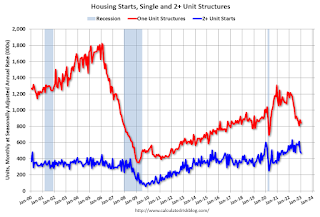 8:30 AM: Housing Starts for February.
8:30 AM: Housing Starts for February. This graph shows single and multi-family housing starts since 1968.
The consensus is for 1.310 million SAAR, up from 1.309 million SAAR.
8:30 AM: The initial weekly unemployment claims report will be released. The consensus is for 205 thousand initial claims, down from 211 thousand last week.
8:30 AM: the Philly Fed manufacturing survey for March. The consensus is for a reading of -14.8, up from -24.3.
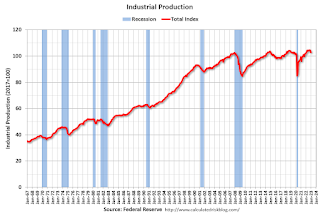 9:15 AM: The Fed will release Industrial Production and Capacity Utilization for February.
9:15 AM: The Fed will release Industrial Production and Capacity Utilization for February.This graph shows industrial production since 1967.
The consensus is for a 0.4% increase in Industrial Production, and for Capacity Utilization to increase to 78.5%.
10:00 AM: University of Michigan's Consumer sentiment index (Preliminary for March).
Friday, March 10, 2023
COVID Mar 10, 2023: Update on Cases, Hospitalizations and Deaths
by Calculated Risk on 3/10/2023 09:03:00 PM

| COVID Metrics | ||||
|---|---|---|---|---|
| Now | Week Ago | Goal | ||
| New Cases per Week2 | 170,576 | 226,995 | ≤35,0001 | |
| Hospitalized2 | 18,561 | 21,235 | ≤3,0001 | |
| Deaths per Week2 | 1,862 | 2,265 | ≤3501 | |
| 1my goals to stop weekly posts, 2Weekly for Cases, Currently Hospitalized, and Deaths 🚩 Increasing number weekly for Cases, Hospitalized, and Deaths ✅ Goal met. | ||||
 Click on graph for larger image.
Click on graph for larger image.This graph shows the weekly (columns) number of deaths reported.
Hotels: Occupancy Rate Down 5.6% Compared to Same Week in 2019
by Calculated Risk on 3/10/2023 04:11:00 PM
U.S. hotel performance fell from the previous week, according to STR‘s latest data through March 4.The following graph shows the seasonal pattern for the hotel occupancy rate using the four-week average.
Feb. 26 through March 4, 2023 (percentage change from comparable weeks in 2022, 2019):
• Occupancy: 62.8% (+3.0%, -5.6%)
• verage daily rate (ADR): $151.35 (+8.9%, +14.1%)
• Revenue per available room (RevPAR): $95.06 (+12.1%, +7.7%)
*Due to the pandemic impact, STR is measuring recovery against comparable time periods from 2019. Year-over-year comparisons will once again become standard after Q1.
emphasis added
 Click on graph for larger image.
Click on graph for larger image.The red line is for 2023, black is 2020, blue is the median, and dashed light blue is for 2022. Dashed purple is 2019 (STR is comparing to a strong year for hotels).
Q1 GDP Tracking
by Calculated Risk on 3/10/2023 03:42:00 PM
From BofA:
The trade deficit in January widened to $68.3bn, the widest deficit in the last three months. Exports increased by 3.4% m/m while imports went up by 3.0%. This increased our tracking estimate for bothexports and imports, while reducing our estimate fornet exports in 1Q. On net, since the last weekly publication, this pushed down our 1Q US GDP tracking estimate from 0.9% q/q saar to 0.7% q/q saar. [Mar 10th estimate]From Goldman:
emphasis added
We left our Q1 GDP tracking estimate unchanged at +2.0% (qoq ar). We also left our domestic final sales forecast unchanged at +2.3%. [Mar 8th estimate]And from the Altanta Fed: GDPNow
The GDPNow model estimate for real GDP growth (seasonally adjusted annual rate) in the first quarter of 2023 is 2.6 percent on March 8, up from 2.0 percent on March 7. [Mar 8th estimate]
Bank Failure #1 in 2023: Silicon Valley Bank
by Calculated Risk on 3/10/2023 12:25:00 PM
Silicon Valley Bank, Santa Clara, California, was closed today by the California Department of Financial Protection and Innovation, which appointed the Federal Deposit Insurance Corporation (FDIC) as receiver. To protect insured depositors, the FDIC created the Deposit Insurance National Bank of Santa Clara (DINB). At the time of closing, the FDIC as receiver immediately transferred to the DINB all insured deposits of Silicon Valley Bank. ... As of December 31, 2022, Silicon Valley Bank had approximately $209.0 billion in total assets and about $175.4 billion in total deposits. At the time of closing, the amount of deposits in excess of the insurance limits was undetermined. The amount of uninsured deposits will be determined once the FDIC obtains additional information from the bank and customers.As of the December 2022, Silicon Valley Bank was the 16th largest US bank in terms of assets.
Comments on February Employment Report
by Calculated Risk on 3/10/2023 09:21:00 AM
The headline jobs number in the February employment report was above expectations, however employment for the previous two months was revised down by 34,000, combined. The participation rate increased, and the unemployment rate increased to 3.6%.
In February, the year-over-year employment change was 4.34 million jobs.
Prime (25 to 54 Years Old) Participation
 Since the overall participation rate is impacted by both cyclical (recession) and demographic (aging population, younger people staying in school) reasons, here is the employment-population ratio for the key working age group: 25 to 54 years old.
Since the overall participation rate is impacted by both cyclical (recession) and demographic (aging population, younger people staying in school) reasons, here is the employment-population ratio for the key working age group: 25 to 54 years old.The 25 to 54 participation rate increased in February to 83.1% from 82.7% in January, and the 25 to 54 employment population ratio increased to 80.5% from 80.2% the previous month.
Average Hourly Wages
 The graph shows the nominal year-over-year change in "Average Hourly Earnings" for all private employees from the Current Employment Statistics (CES).
The graph shows the nominal year-over-year change in "Average Hourly Earnings" for all private employees from the Current Employment Statistics (CES). Wage growth has trended down after peaking at 5.9% YoY in March 2022 and was at 4.6% YoY in February.
Part Time for Economic Reasons
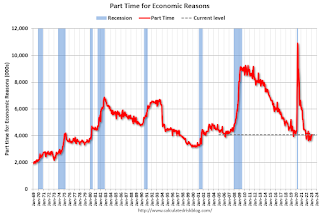 From the BLS report:
From the BLS report:"The number of persons employed part time for economic reasons, at 4.1 million, was essentially unchanged in February. These individuals, who would have preferred full-time employment, were working part time because their hours had been reduced or they were unable to find full-time jobs."The number of persons working part time for economic reasons increased in February to 4.067 million from 4.050 million in January. This is at pre-recession levels.
These workers are included in the alternate measure of labor underutilization (U-6) that increased to 6.8% from 6.6% in the previous month. This is down from the record high in April 22.9% and up from the lowest level on record (seasonally adjusted) in December 2022 (6.5%). (This series started in 1994). This measure is below the level in February 2020 (pre-pandemic).
Unemployed over 26 Weeks
 This graph shows the number of workers unemployed for 27 weeks or more.
This graph shows the number of workers unemployed for 27 weeks or more. According to the BLS, there are 1.057 million workers who have been unemployed for more than 26 weeks and still want a job, down from 1.111 million the previous month.
This is at pre-pandemic levels.
Summary:
The headline monthly jobs number was above expectations; however, employment for the previous two months was revised down by 34,000, combined. The headline unemployment rate increased to 3.6%.



